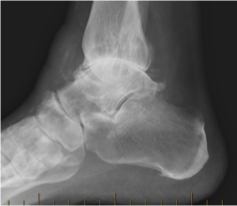A guide to ankle fusion surgery.
What is an ankle arthritis?
Ankle arthritis develops when the ankle joint has damaged or worn-out cartilage. The symptoms of ankle arthritis are pain, swelling and stiffness. Usually, symptoms develop gradually overtime.

What is an ankle fusion?
Most ankle arthritis can be treated without surgery. An ankle fusion is an operation considered for severe ankle arthritis, once non-operative treatments have been exhausted and if your symptoms remain significant. It is a well-established surgical treatment and has been proven to be effective. The goals are to permanently stiffen the ankle joint and the lack of movement alleviates pain.
What happens during an ankle fusion?
In most cases the operation is performed under general anaesthetic (whilst you are asleep). Alternatively, you can have a spinal or regional anaesthetic, which just numbs the leg.
The operation involves removing the damaged cartilage of the ankle joint. Then the two main bones of the ankle joint (tibia and talus) are placed in the correct position and are rigidly held together using metal screws. This allows natural bone healing to fuse your ankle joint.
Where possible, the operation will be performed using keyhole surgery with small surgical cuts either side of your ankle (arthroscopic ankle fusion). Depending on the shape of your ankle, keyhole surgery may be unsuitable. If so, the operation will involve larger surgical cuts, usually on the outside of your ankle (open ankle fusion). Occasionally some extra bone is required to help with the healing, either your own bone or from donor bone.
Once the operation is completed, the wounds are closed with stitches, local anaesthetic is given to provide pain relief for the first few hours after surgery and you will be placed in a temporary plaster cast.
What are the risks of an ankle fusion?
The risks of any operation generally relate to the anaesthetic and the surgical procedure.
You will be able to discuss your anaesthetic options and associated risks with the anaesthetist before your surgery. With a general anaesthetic, the risks will vary depending on your general health.
The main surgical risks of an ankle fusion are listed below, but it is not exhaustive. These will be further explained in the outpatient clinic.
Blood clots (leg or lung) – There is small risk of developing a blood clot after major surgery. You will be individually assessed and may be given blood thinning medication to reduce the risk of developing a blood clot.
Failure of fusion – There is a 10% risk your ankle joint will not fuse together and may need to be rectified with a second operation. Patients who smoke are at a much higher risk of this complication. We will therefore ask you to stop smoking (including nicotine vapes) before surgery and while your ankle joint is fusing together. We can direct you to services that can help with smoking cessation.
Infection – The risk of infection with any foot and ankle operation is up to 5%. The majority are minor infections that can be simply treated with antibiotics. Occasionally, some patients can develop a deeper infection that might require another operation.
Nerve injury – With an operation, there is always a small risk of injuring or stretching the surrounding nerves, which can lead to numbness or even weakness. These symptoms mostly resolve in time, but they can persist.
Swelling – The ankle will swell after surgery in response to the surgery and the healing process. It will take more than 12 months for the swelling to settle and some may persist.
Mal-position – When the ankle is fused it may not be in the correct position. If the position of the ankle is problematic some patients may consider further surgery to adjust this. Great care is taken during surgery to avoid this complication.
Prominent metalwork – If the metalwork in your ankle becomes a problem, you can have another operation to remove it. After nine months the ankle fusion will be solid so the screws and / or plate can be removed if required.
Progression of arthritis – By fusing the ankle joint, this places increased stress on joints in your foot and they can subsequently develop arthritis. This may require further treatment.
Chronic regional pain syndrome – Following foot and ankle surgery a very small proportion of patients can develop chronic regional pain syndrome. Your foot becomes indefinitely painful, swollen and sensitive. If you develop this, you may require specialist care from a pain consultant.
What happens after my operation?
When will I go home after surgery?
After surgery, most patients can go home the following day. You may require additional time in hospital, if you have other significant medical problems or general poor mobility.
Will I be able to walk on it after surgery?
For the first six weeks after surgery you are advised not to put any weight through your operated leg. Before you go home the physiotherapist will make sure you are safe to get around on crutches. Some patients though find crutches difficult. A knee scooter can be easier to use and information can be provided on this.
Also, in the first few weeks keep your leg elevated as much as possible to help reduce the swelling and aid wound healing. It is important that your cast remains dry and you may find using a waterproof cover helpful (www.limboproducts.com).
When will I be seen after surgery?
You will be seen two weeks after surgery in the outpatient clinic. Your wounds will be checked, your stitches removed, and a lightweight fibreglass cast will be applied.
You will then be seen six weeks after surgery with an X-ray. If everything is progressing well, you will be provided either with a removable cast or a surgical boot and you can slowly put weight through your operated leg as your comfort levels allow.
You will be seen again 12 weeks after surgery with another X-ray. If your ankle is fusing together you can go into your own supportive shoes (preferably a lace-up boot). You will be referred to our specialist physiotherapists for strengthening exercises and help with your walking pattern (gait). Further appointments will depend on your individual progress.
When can I go back to work?
If you have a sedentary job (desk based) and are able to elevate your foot, you can return to work six weeks after surgery. If you have a more physically strenuous job, you may need significantly longer off work. Generally, after an ankle fusion it takes up to 12 months to gain the full benefit.
When can I drive?
You can start driving when you are comfortably walking in your own footwear. If you cannot safely make an emergency stop your insurance will not cover you in the event of an accident. Start by sitting in the car and trying the pedals, then drive round the block. Drive short distances before long ones. If you are having surgery on your left leg and drive an automatic car, you could consider to start driving sooner, but only if you are safe to do so.
How quickly can I return to activities?
After an ankle fusion it varies how quickly people can return back to some activities. When comfortable in your own shoes, gradually build up your walking distances. Playing golf is possible but it is rare to participate in running sports. You will be guided by our physiotherapists during the rehabilitation program.
When can I fly after surgery?
If you are flying after recent surgery you are at an increased risk of developing a blood clot in one of the deep veins in your body, usually the leg (deep vein thrombosis or DVT). Please ask your surgeon for individual guidance on how long to delay flying after your surgery. Also, each airline has its own regulations about flying after surgery and you will need to check with your airline before flying.
Wellbeing advice
Patients that have a healthy diet, take regular exercise and refrain from smoking are more likely to experience a quicker recovery with a more successful outcome from their surgery.
Taking vitamin C supplements for six weeks before surgery and six weeks after surgery can also be beneficial. You can purchase them from your local pharmacy or supermarket.
If you have any concerns about your general health and well-being (diet, exercise, smoking cessation) you are encouraged to discuss this with your GP, who will be able to provide advice on the options available to you.
We hope this leaflet has answered any questions you might have. If you have any further queries, please feel free to discuss them with any of the medical or nursing staff.
Useful links:
Last modified: April 6, 2023







